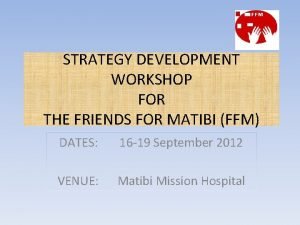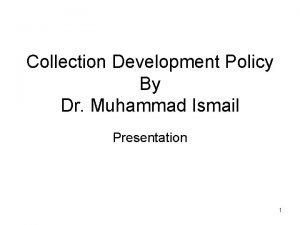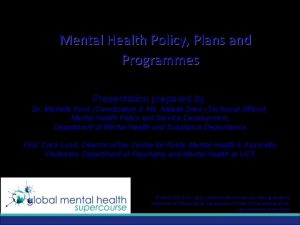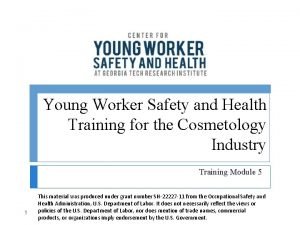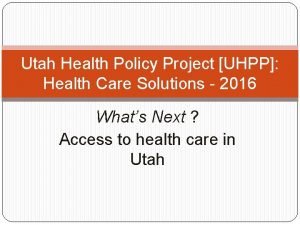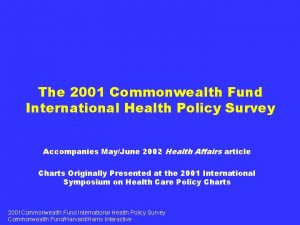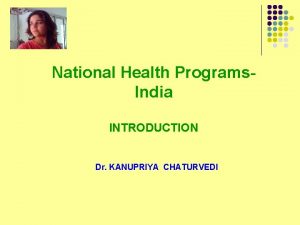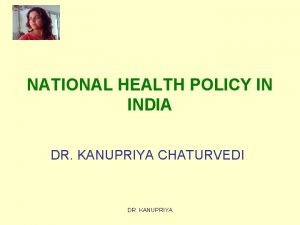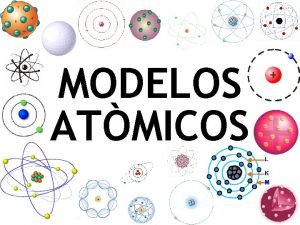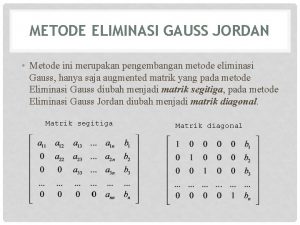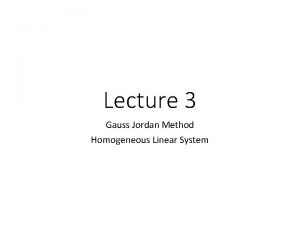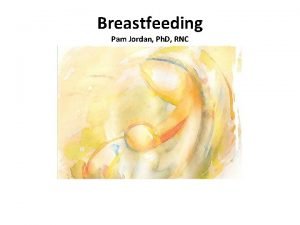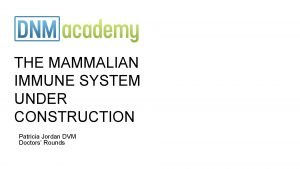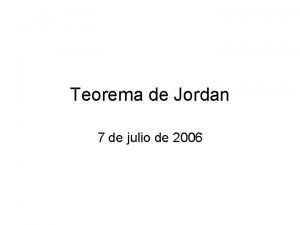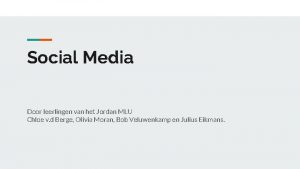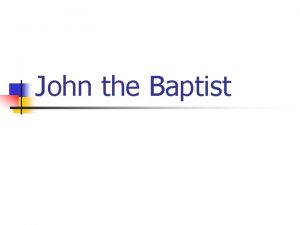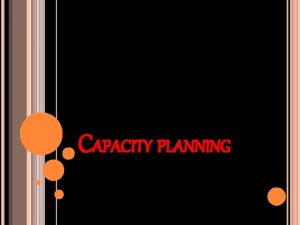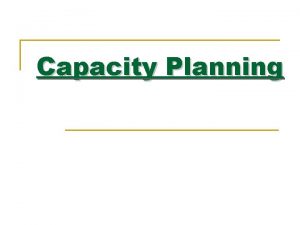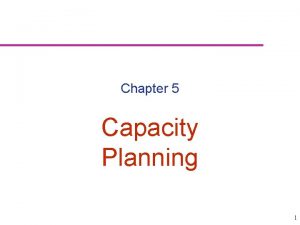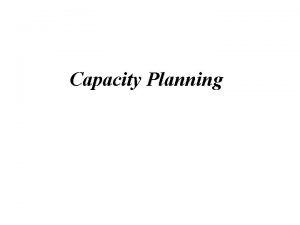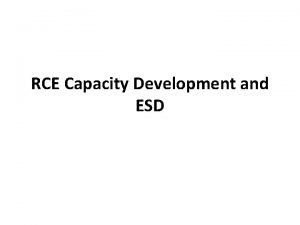Health Policy Situation Jordan RESCAPMED Capacity Development Workshop





























































- Slides: 61

Health Policy Situation: Jordan RESCAP-MED Capacity Development Workshop Health Policy Evaluation Amman, Jordan 3 -6 June 2013 Musa Ajlouni, Ph. D Philadelphia University 10/27/2020 1

Socioeconomic Indicators for Jordan 2011 Jordan is a middle income country. Annual per capita income: US$4, 628. unemployment rate : 12. 5%(10. 8% for males , 19. 9% for females). Poverty incidence is 14. 4% ( rural 37% urban 29% ). 10/27/2020 2

Jordan demographic indicators, 2011 Indicators Total population Population Growth Rate 6249000 2. 2 Dependency Ratio 68. 2 % population <15 years 37. 3 Total Fertility Rate 3. 8 10/27/2020 3

Jordan Health Indicators, 2011 Life expectancy: 73 years. Crude death rate: 7 per 1000 Infant mortality: 23 per 1000 Live Births Maternal mortality: 19. 1 per 100, 000 Live Births 10/27/2020 4

Non-communicable Diseases in Jordan: Trends and Challenges Top 5 causes of Mortality, 2009 Rank 69 % of all deaths Mortality 1 Diseases of circulatory system (36%) 2 Neoplasm's (15%) 3 External Causes of Mortality (10%) 4 Endocrine, nutritional and metabolic diseases (8%) 5 Certain conditions originating I in the perinatal period (7%) 10/27/2020 5

Human Development Index: Health, Education and Income, Jordan 2011 Health Development Index scored the highest (0. 841) Source: UNDP: http: //hdrstats. undp. org/en/countries/profiles/JOR. htm 10/27/2020 6

Expenditures on health(2011) Total health expenditure (JD) 1. 581 billion Total health expenditure/capita (JD) 252. 9 Total health expenditure as % of GDP 7. 72 Public sector expenditure as % of total health expenditure 66. 85 Expenditure on pharmaceuticals(427. 9 million JD) 27. 56 % of total HE % of government budget allocated to health sector 9. 14 10/27/2020 7

Distribution of Public Expenditure by Function 2011 JD Curative 75. 3 % Primary 15. 9 % Administration 7. 3 % Training 1. 5 % 10/27/2020 8

Out of Pocket 10/27/2020 9

out-of-pocket expenditure Out-of-pocket health expenditure Risk of financial catastrophe 10 Push some households into poverty Reduce expenditures on other basic needs May cause households to forgo seeking health care and suffer illness 10/27/2020 10 10

Source: United Nations Population Division, 1998 World Population Prospects 10/27/2020 11

Re-Estimated 10/27/2020 12

10/27/2020 13

Population Structure: Impacts on HP 10/27/2020 14

Jordan health Care Sub - Systems 10/27/2020 15

Key MOH Roles in Health Care (as mandated by PH Law 47 for 2008) Public Health System Monitoring Information Dissemination Cost Containment Facility/Professional Regulation Provide and Regulate Insurance Health Workforce Education Training Provide/Finance Service 10/27/2020 16

Jordan Ranks 83/190 According to WHO Ranking of the World’s Health Systems 1 France 2 Italy 3 San Marino 4 Andorra 5 Malta 6 Singapore 7 Spain 8 Oman 9 Austria 10 Japan 11 12 13 14 15 16 17 18 19 20 Norway Portugal Monaco Greece Iceland Luxembourg Netherlands UK Ireland Switzerland Source: http: //www. who. int/healthinfo/paper 30. pdf 10/27/2020 17

Health Care System Achievements Extensive network of PHC facilities Physician to population ratio is higher than most of MENA Strong higher education system 76 % of the population in Jordan is covered by formal health insurance Government commitment Improvement in health indicators Modern health care infrastructures Accreditation Program Medical Tourism 10/27/2020 18

Health System Challenges Morbidity Increase of NCD and injuries Double Burden of Disease Unhealthy behaviors and life style 10/27/2020 19

Health System Challenges Demography High growth rate due to high fertility rates and forced migration waves. High dependency ratios. Increasing proportion of the population that is aging. Unplanned urbanization (about 50% of population lives in Greater Amman Area). Scarcity of water resources and Limited natural resources and arable land. 10/27/2020 20

Going forward, the increasingly aging Jordan population is expected to further strain government budget over the next decade Population Breakdown by Age (In Million) (2005 / 2020) 100% 4% Government Health Care Expenditure (In JD Million) (2004 / 2020) CAGR (2005 -2020) 100% 5% 65+ 5% 26% 40 -64 6% 920 Millions in 2011 16% x 2. 6 36% 35% 20 -39 2% 0 -19 0% 45% 33% Elderly Dependenc y Ratio* 6% 8% Note: (*) Elderly dependency ratio is the population over 65 divided by those between ages 15 and 64 Source: US Census Bureau; GPD Team analysis 10/27/2020 21

Health System Challenges Inequalities Access to health services is uneven across Governorates Low income population is not getting all the benefits of the Mo. H coverage scheme High Out-of- Pocket Spending Public funds are subsidizing some wealthy households Around 25% of the population does not have any sort of insurance coverage 10/27/2020 22

Findings from the Jordan Healthcare Utilization and Expenditures Survey, 2006 Health System Challenges Inequalities 75 % of out of pocket expenditures on outpatient care for pharmaceuticals. This represents a burden to the population as a whole and to at-risk groups in particular. The elderly , females and the poor spend more out of pocket on outpatient care than others do. Some demographic groups (the elderly and the illiterate) have average expenditures on outpatient care that exceed 10 percent of household income. Females pay out of pocket expenditures three times as much as males on Inpatient Care. 10/27/2020 23

Health System Challenges Inefficiencies High spending on health and medicines Duplication of HI Coverage Low Utilization of PHCs Low Productivity 10/27/2020 24

Health System Challenges Funding Expenditure on health care is as high as some developed countries. Public health expenditure is likely to further increase over the next decades in light of an aging population 10/27/2020 25

Health System Challenges Governance Poor monitoring and Coordination Uncontrolled Private Sector Limited public-private partnerships Management issues Poor HIS Overlapping and duplication of governance functions 10/27/2020 26

Health System Challenges Human Resources Imbalances between output and market need for many professions. Re-licensing of health professionals has not been introduced. High drop out rate of qualified health professionals : internal and external Gender imbalances in training intake for many health professions. Regional, geographical , level of care imbalances). Weak performance management Centralization of decisions regarding HRH recruitment, placement, termination and compensation. 10/27/2020 27

Health Policy in Jordan as a Lever to Change Action s ps e a i lic he G o P et dg i r o. B t Health System Concerns, Challenges, Gaps Achieve Specific Objectives üDecrease Fertility Rate üDecrease Maternal Mortality rate üDecrease Infant Mortality Rate üAchieve Universal Coverage? üDecrease expenditures on pharmaceuticals ? 10/27/2020 28

Four Health Policy Eras Era I: Pre MOH 1921 -1946 Pre/Emerging System Period Minimal licensure and professional standards No health insurance Minimal public investments No MOH( Health Directorate only) Infectious disease leading cause of death Life expectancy ~45 years 10/27/2020 29

Four Health Policy Eras Era II: Institulaization, Health Education, Professionalization 1950 s to 1970 s ( Public Sector Growth) MOH established in 1950 First Nursing College(1953) First Medical Faculty 1970 Widespread licensure, public sector regulation Development of health insurance. First Health Insurance (Armed Forces)1963, Civel Health Insurance, 1965 10/27/2020 30

Four Health Policy Eras Era II: ( Public Sector Growth) /Cont. . Development of PHC and Tertiary Healthcare( KHMC and Amman Large Hospital 1973) HHC 1977 Medical Associations 10/27/2020 31

Four Health Policy Eras Era III: Private Sector Booming and Medical Tourism 1980 s - 2000 ( Private Sector Growth) (life expectancy ~70 s) Sophisticated Medical Technology Emergence of Chronic Disease as Leading Cause of Death Increased Expenditure on Health System Planning 10/27/2020 32

Four Health Policy Eras Era IV: Integrating Health Policy with National Policy 2000 - through today (Health Policy Integration) Evidence Based HP NHA Cancer , Death Registries, Community-based Studies Activation of the Role of HHC(HHC Law 2009) FDA (2003) Expanding Health Insurance Quaternary care Quality and Accreditation Programs Cost Containment Jordan National Agenda(2005 -2017), (2017 -2022) 10/27/2020 33

10/27/2020 34

The Jordanian National Agenda: A Strategy for Social Welfare developed by a 27 -member committee through dialogues with hundreds of Jordanian citizens, is a 10 -year plan covering eight themes across the fields of political, institutional, economic, educational, and social reform. The Agenda includes measurable indicators for success and clear milestones linked to a clear timetable. Budgetary requirements to implement the Agenda are also integrated into the document, so that resources can be allocated to ensure the Agenda's enactment. 10/27/2020 35

Social Welfare contributes to the achievement of key constituents of every modern society, namely: democracy, solidarity, social organization and economic effectiveness Social Welfare Contribution to a Modern Society Safe and Secure Citizens Healthy Citizens Social Welfare Economically Active Citizens Economic Effectiveness Social Organization Solidarity Democracy Educated Citizens Modern Society Source: Jordan National Agenda 10/27/2020 36

(Health Policy Integration) Jordan National Agenda (2005 -2017), (2017 -2022) 10/27/2020 37

Health as part of National Social Welfare Package “All social interventions intended to enhance or maintain the social functioning of human beings” Social Services Health Care Providing adequate access to health care Welfare Assistance Education Providing education Ensuring a minimum level of income and decent life conditions for the vulnerable segment of the population Personal Social Services Unemployment Assistance Ensuring a safety net is put in place for the unemployed Providing vocational training and job placement assistance Providing support services for vulnerable segments: ◦ Mentally ill people ◦ Disabled People Source: Jordan National Agenda 10/27/2020 38

Most developed countries adopt an “Institutional” stance while developing countries adopt a “Residual” stance towards social welfare, with Jordan adopting a fairly balanced stance Governments Attitude Towards Social Welfare Brazil Egypt South Africa Peru Developing Countries USA Mexico Jordan “Residual” Welfare provision is often positioned as targeted to the poor Sweden Malaysia Germany France Canada UK “Institutional” Developed Countries Welfare is provided for the population as a whole, in the same way as public services like roads or water might be Source: Jordan National Agenda 10/27/2020 39

Coverage of social services varies by country, with developing countries being generally mostly selective in their provision of social services Source: Jordan National Agenda Canada Sweden France 10/27/2020 Sweden Canada Sweden France Canada Germany UK UK Germany France Germany USA UK France Germany Jordan UK USA Mexico Jordan Mexico S. Africa Jordan Mexico Jordan Personal Social Services S. Africa Unemployme nt Assistance S. Africa Welfare Assistance Mexico Social Services Education Universal benefits and services are made available to everyone as a “right”, or at least to whole categories of people (like 'old people' or 'children‘) Coverage USA Mexico S. Africa Selective benefits and services are made available on the basis of individual need, usually determined by a test of income Health Care “Universal” Social Welfare Programs by Type France “Selective” 40

10/27/2020 41

High Health Council: HP Formulation Proposing and initiating national health policy and strategic health plans. Coordinating the major activities of health subsectors (MOH, RMS, university hospitals, private health sector, etc. ). Proposing solutions to the major problems of the health care system (HCS). Adopting of health system research agenda and facilitating the implementation of this agenda. 10/27/2020 42

High Health Council: The House of all Health Stakeholders 10/27/2020 43

National Health Strategy (2008 -2012) Milestones of Health Policy in Jordan üStrategic partnership among all sectors. üInvestment in enhancing Jordan pioneer position in the region. üEnsuring financial protection for all citizens. üLiberating the systems and directing the investment towards the health sectors. üHuman resources development. üControlling expenditure and efficiently. üDirecting output of medical and health sciences to meet market needs. üStrengthening collaboration with international organizations. üRelying on studies and research to determine priorities and direct projects. üStrengthening and directing support for health care services. 10/27/2020 44

National Health Strategy and Plan of Action 2008 -2012: Three Main Pillars Reduce Costs (Efficiency) Improve Accessibility (Effectiveness and Equity) Increase Quality 10/27/2020 45

National Health Strategy (2008 -2012) Strategic Goals: - Expanding health insurance to all citizens. - Ensuring equality in access to health services regardless of the ability to pay. - Providing efficient, high-quality health care services in accordance with international standards. - Increasing financial support allocated to primary health care services. -Unifying, standardizing, and computerizing administrative, financial and information systems at all levels of service providers. - Strengthening intersectional partnership. - Developing and updating first-aid and emergency system within the Kingdom. - Activating reproductive health programs. - Supporting the most vulnerable groups, particularly the poor and the elderly. - Institutionalizing NHA and public expenditure review. 10/27/2020 46

Universal coverage that can be attained : covering all, for most services, at reasonable cost Total health expenditure % Cost covered Pooled funds Depth and quality (services covered) Breadth (% population covered) 10/27/2020 47 47

National Health Strategy (2008 -2012) Strategic Themes 10/27/2020 48

National Health Strategy (2008 -2012) Manpower Theme: I. Adopting an ideal policy to qualify human resources through: § § II. § § Institutionalizing education and training for all technical and management personnel. Endorsing continuous medical education. Recruiting qualified technical personnel and retaining them through: Developing and implementing incentives system. Approving job descriptions. 10/27/2020 49

National Health Strategy (2008 -2012) Manpower Theme: III. Endorsing evaluation programs for qualified technical § § personnel through: Setting performance indicators. Periodic evaluation and certification. IV. Directing educational outputs to meet market needs for § § health manpower through: Periodic evaluation of educational outputs to identify needs. Designing educational polices for studying health and medical sciences within the Kingdom, and organizing the study of these sciences abroad. 10/27/2020 50

National Health Strategy (2008 -2012) Process Theme: I. Strengthening the PHC services focusing on: §Providing preventive and curative services in health care centers through the aspect of family medicine. §Raising health awareness. §Encouraging community and voluntary work. §Meeting the needs of special categories in the community, such as children, women, those who are getting married, elderly, those with special needs, and those subjected to violence. §Encouraging the practice of healthy lifestyles. §Confronting disease determinants and risk factors. 10/27/2020 51

National Health Strategy (2008 -2012) § § § Process Theme: II. Enhancing the abilities of secondary/tertiary health care services through: Providing curative care services according to the best international standards through the implementation of accreditation programs. Establishing an updated first-aid and emergency system. Connecting primary and secondary health care services through an effective referral system. 10/27/2020 52

National Health Strategy (2008 -2012) Process Theme: III. Improving the management of health information through: § § § Integrated information programs. Reference disease classification for all sectors. Medical data based on studies and research. 10/27/2020 53

National Health Strategy (2008 -2012) Process Theme: IV. Institutional development: § Updating work methods. § Authenticating processes and simplifying procedures. § Encouraging studies and research to serve as the basis formulating health polices. § Assuring job security and improving the work environment 10/27/2020 54

National Health Strategy (2008 -2012) Financial Theme: I. Assuring the sustainability of the health system by endorsing medical finance as the basis for providing services through: § Periodic revision of health expenditures according to national health accounts. § Performance reviews that depend on budgeting and endorsement of results-oriented budgeting. § Integrated partnership among the sectors and endorsing the certificate of need. § Adopting Master planning to raise the operational efficiency of resources. 10/27/2020 55

National Health Strategy (2008 -2012) Financial Theme: II. Focusing on financial efficiency through: § Endorsing the certificate of need. § Rationalizing drug consumption. § Endorsing the joint purchasing method. § Encouraging investment in the health sector to support medical tourism. 10/27/2020 56

Challenges related to Health Policy No real involvement of all stakeholders. Available evidence is not fully utilized. Turnover of governments. Shortage of integrated technical personnel at HHC. Weak or lack of operational plans. Weak implementation. 10/27/2020 57

Health Policy Makers in Jordan: “Now I UNDERSTAND You!” 10/27/2020 58

A lesson from the Business World “Your legacy should be that you made it better than it was when you got it. ” Lee Iacocca "Lee" Iacocca is an American businessman known for engineering the Ford Mustang and Ford Pinto cars, being let go from Ford Motor Company, and his revival of the Chrysler Corporation in the 1980 s. 10/27/2020 59

The Only Constant is the Change , Albert Einstein 10/27/2020 60

Thank You 10/27/2020 61
 Production units have an optimal rate of output where:
Production units have an optimal rate of output where: Strategy development workshop
Strategy development workshop Strategy development workshop
Strategy development workshop Business development workshop
Business development workshop Organizational development workshop
Organizational development workshop Workshop health and safety poster
Workshop health and safety poster Policy development steps
Policy development steps Collection development policy
Collection development policy National policy and legislation related to child health
National policy and legislation related to child health Existanxe
Existanxe Mental health policy, plans and programmes michelle funk
Mental health policy, plans and programmes michelle funk Safety and health policy example
Safety and health policy example Horizonnjhealth.com register
Horizonnjhealth.com register Utah health policy project
Utah health policy project Policy analysis problem statement example
Policy analysis problem statement example Commonwealth fund international health policy survey
Commonwealth fund international health policy survey Dr. kanupriya chaturvedi
Dr. kanupriya chaturvedi National health policy 2002
National health policy 2002 Pacific health policy group
Pacific health policy group Kansas health policy authority
Kansas health policy authority Health policy triangle framework
Health policy triangle framework Rose hsu jordan
Rose hsu jordan Rose hsu jordan
Rose hsu jordan Gilgal, bethel, jericho jordan map
Gilgal, bethel, jericho jordan map Jordan arc
Jordan arc Michael jordan bodily kinesthetic intelligence
Michael jordan bodily kinesthetic intelligence I hate careless people thats why i like you
I hate careless people thats why i like you Symbols in great gatsby chapter 4
Symbols in great gatsby chapter 4 Great gatsby chapter 3 quotes
Great gatsby chapter 3 quotes Taxonomía de jordan
Taxonomía de jordan Metode gaus
Metode gaus Brianna jordan hot
Brianna jordan hot Contoh soal eliminasi gauss
Contoh soal eliminasi gauss Metode gauss jordan
Metode gauss jordan Metodo de crout
Metodo de crout Jordan skyward
Jordan skyward Modelo atomico actual creador
Modelo atomico actual creador Cara eliminasi gauss
Cara eliminasi gauss Gaussian elimination echelon form
Gaussian elimination echelon form 12 stones at gilgal pictures
12 stones at gilgal pictures Gauss jordan method
Gauss jordan method Formule de boucherot
Formule de boucherot Joshua 3 10
Joshua 3 10 Jordan university of science and technology
Jordan university of science and technology Jordan university of science and technology
Jordan university of science and technology January starts the year poem risa jordan
January starts the year poem risa jordan Gju
Gju Gaussian elimination method
Gaussian elimination method Eliminasi gaus
Eliminasi gaus Michael i jordan
Michael i jordan Gregory b jordan esq
Gregory b jordan esq Wesley bad boy boone
Wesley bad boy boone Pam jordan
Pam jordan Jordan gildersleeve
Jordan gildersleeve Genessee park to othello
Genessee park to othello Jordan belfort presentation
Jordan belfort presentation Patricia jordan dvm
Patricia jordan dvm Ministry of justice jordan
Ministry of justice jordan Tom buchanan symbol
Tom buchanan symbol Why does george wilson lock myrtle in the bedroom
Why does george wilson lock myrtle in the bedroom Teorema de jordan
Teorema de jordan Jordan mlu
Jordan mlu

